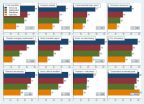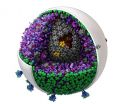West Antarctic melt rate has tripled: UC Irvine-NASA
2014-12-02
(Press-News.org) Irvine, Calif., Dec. 2, 2014 - A comprehensive, 21-year analysis of the fastest-melting region of Antarctica has found that the melt rate of glaciers there has tripled during the last decade.
The glaciers in the Amundsen Sea Embayment in West Antarctica are hemorrhaging ice faster than any other part of Antarctica and are the most significant Antarctic contributors to sea level rise. This study is the first to evaluate and reconcile observations from four different measurement techniques to produce an authoritative estimate of the amount and the rate of loss over the last two decades.
"The mass loss of these glaciers is increasing at an amazing rate," said scientist Isabella Velicogna, jointly of the UC Irvine and NASA's Jet Propulsion Laboratory. Velicogna is a coauthor of a paper on the results, which has been accepted for Dec. 5 publication in the journal Geophysical Research Letters.
Lead author Tyler Sutterley, a UCI doctoral candidate, and his team did the analysis to verify that the melting in this part of Antarctica is shifting into high gear. "Previous studies had suggested that this region is starting to change very dramatically since the 1990s, and we wanted to see how all the different techniques compared," Sutterley said. "The remarkable agreement among the techniques gave us confidence that we are getting this right."
The researchers reconciled measurements of the mass balance of glaciers flowing into the Amundsen Sea Embayment. Mass balance is a measure of how much ice the glaciers gain and lose over time from accumulating or melting snow, discharges of ice as icebergs, and other causes. Measurements from all four techniques were available from 2003 to 2009. Combined, the four data sets span the years 1992 to 2013.
The glaciers in the embayment lost mass throughout the entire period. The researchers calculated two separate quantities: the total amount of loss, and the changes in the rate of loss.
The total amount of loss averaged 83 gigatons per year (91.5 billion U.S. tons). By comparison, Mt. Everest weighs about 161 gigatons, meaning the Antarctic glaciers lost a Mt.-Everest's-worth amount of water weight every two years over the last 21 years.
The rate of loss accelerated an average of 6.1 gigatons (6.7 billion U.S. tons) per year since 1992.
From 2003 to 2009, when all four observational techniques overlapped, the melt rate increased an average of 16.3 gigatons per year -- almost three times the rate of increase for the full 21-year period. The total amount of loss was close to the average at 84 gigatons.
The four sets of observations include NASA's Gravity Recovery and Climate Experiment (GRACE) satellites, laser altimetry from NASA's Operation IceBridge airborne campaign and earlier ICESat satellite, radar altimetry from the European Space Agency's Envisat satellite, and mass budget analyses using radars and the University of Utrecht's Regional Atmospheric Climate Model.
The scientists noted that glacier and ice sheet behavior worldwide is by far the greatest uncertainty in predicting future sea level. "We have an excellent observing network now. It's critical that we maintain this network to continue monitoring the changes," Velicogna said, "because the changes are proceeding very fast."
INFORMATION:
About the University of California, Irvine:
Founded in 1965, UCI is the youngest member of the prestigious Association of American Universities. The campus has produced three Nobel laureates and is known for its academic achievement, premier research, innovation and anteater mascot. Led by Chancellor Howard Gillman, UCI has more than 30,000 students and offers 192 degree programs. Located in one of the world's safest and most economically vibrant communities, it's Orange County's second-largest employer, contributing $4.8 billion annually to the local economy.
Media access: Radio programs/stations may, for a fee, use an on-campus ISDN line to interview UC Irvine faculty and experts, subject to availability and university approval. For more UC Irvine news, visit news.uci.edu. Additional resources for journalists may be found at communications.uci.edu/for-journalists.
ELSE PRESS RELEASES FROM THIS DATE:
2014-12-02
ARGONNE, Ill. ― A team of researchers from the U.S. Department of Energy's Argonne National Laboratory and Ohio University have devised a powerful technique that simultaneously resolves the chemical characterization and topography of nanoscale materials down to the height of a single atom.
The technique combines synchrotron X-rays (SX) and scanning tunneling microscopy (STM). In experiments, the researchers used SX as a probe and a nanofabricated smart tip of a STM as a detector.
Using this technique, researchers detected the chemical fingerprint of individual ...
2014-12-02
West Orange, NJ. December 2, 2014. Stroke researchers have found that the presence of frontal lesions predicts better functional improvement in individuals with spatial neglect who received prism adaptation therapy. "Integrity of medial temporal structures may predict better improvement of spatial neglect with prism adaptation treatment" (doi: 10.1007/s11682-012-9200-5) was published in September in the Neuroimaging and Rehabilitation Special Issue of Brain Imaging & Behavior. The authors are Peii Chen, PhD, Priyanka Shah, and A.M. Barrett, MD, of Kessler Foundation, Kelly ...
2014-12-02
To arrange for an interview with a researcher, please contact the Communications staff member identified at the end of each tip. For more information on ORNL and its research and development activities, please refer to one of our media contacts. If you have a general media-related question or comment, you can send it to news@ornl.gov.
IMAGING - Clearer brain scans ...
A clever signal noise reduction strategy developed by a team that includes Oak Ridge National Laboratory's Ben Lawrie could dramatically improve brain imaging. By using quantum correlated beams of light, ...
2014-12-02
New Rochelle, NY, December 2, 2014--A study of active duty U.S. Marines who suffered a recent or previous concussion(s) examined whether persistent post-concussive symptoms (PPCS) and lingering effects on cognitive function are due to concussion-related brain trauma or emotional distress. The results are different for a recent concussion compared to a history of multiple concussions, according to the study published in Journal of Neurotrauma, a peer-reviewed journal from Mary Ann Liebert, Inc., publishers. The article is available Open Access on the Journal of Neurotrauma ...
2014-12-02
DURHAM, N.H. - Environmentalists dispirited by the Republicans' dominance of the recent midterm elections can take heart: non-Tea Party Republicans' views on science and environmental issues are closer to those of Independents than to Tea Party supporters. That's the primary finding of new research by University of New Hampshire sociologists, published this week in the journal Environmental Politics.
"Across a range of science and environmental issues, non-Tea Party Republicans are more similar to Independents than they are to Tea Party supporters, and those divisions ...
2014-12-02
Witnessing violence by parents or a parent's intimate partner can trigger a chain of negative behaviors in some children that follows them from preschool to kindergarten and beyond, according to researchers at Case Western Reserve University.
But girls and boys can be affected differently, researchers concluded. While girls tend to internalize their exposure to such violence, boys are more inclined to act out aggressively, said Megan R. Holmes, PhD, MSW, assistant professor at the Jack, Joseph and Morton Mandel School of Applied Social Sciences at Case Western Reserve ...
2014-12-02
The Valle de Aguán spiny-tailed iguana is a critically endangered species found in Honduras. A recent survey of people living in the region shows that, although residents are aware of the endangered status of the species, the iguana continues to be hunted for food. Of particular concern is the preference for the consumption of female iguanas that are gravid (carrying eggs in their body).
"In this study we worked to gain a better understanding of how humans are harvesting the species for food," said Stesha Pasachnik, Ph.D., a lead researcher on the study and ...
2014-12-02
LA JOLLA, CA - December 1, 2014 - Researchers can now explore viruses, bacteria and components of the human body in more detail than ever before with software developed at The Scripps Research Institute (TSRI).
In a study published December 1 in the journal Nature Methods, the researchers demonstrated how the software, called cellPACK, can be used to model viruses such as HIV.
"We hope to ultimately increase scientists' ability to target any disease," said Art Olson, professor and Anderson Research Chair at TSRI who is senior author of the new study.
Putting cellPACK ...
2014-12-02
PROVIDENCE, R.I. [Brown University] -- If decades of effort to bring more underrepresented minority students into science, technology, engineering and mathematics (STEM) fields were considered a grand chemistry experiment, then the modest results would suggest that while the formula may not be wrong, it may well be incomplete, according to a new article in the journal CBE-Life Sciences Education.
"I don't necessarily want to say that we've been doing it wrong all along, it's just that there are other ideas we can bring in," said lead author Andrew G.Campbell, a Brown ...
2014-12-02
West Orange, NJ. December 1, 2014. Kessler Foundation researchers have authored a new article that provides insight into the variable impact of traumatic brain injury (TBI) on long-term memory. The article, "Working memory capacity links cognitive reserve with long-term memory in moderate to severe TBI: a translational approach," was epublished ahead of print on October 7 in the Journal of Neurology (10.1007/s00415-014-7523-4). The authors are Joshua Sandry, PhD, John DeLuca, PhD, and Nancy Chiaravalloti, PhD, of Kessler Foundation. This study was supported by grants ...
LAST 30 PRESS RELEASES:
[Press-News.org] West Antarctic melt rate has tripled: UC Irvine-NASA




